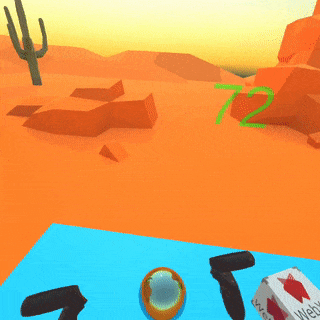WebXR Export
You can check the live demo here.
Or the XR Interaction Toolkit demo here.
Develop and export WebXR experiences using the Unity Engine.
WebXR Export supports both Augmented Reality and Virtual Reality WebXR API immersive sessions.
It integrates the WebXR JavaScript API to Unity WebGL and lets you develop experiences in the familiar editor using C#.
❤Sponsor to support the development❤

💾 Downloads
Better option: Import WebXR Export and WebXR Interactions packages from OpenUPM.
Or import the packages from git, more info at WebXR Export and WebXR Interactions.
📄 Documentation
For more info on getting started and how to use WebXR Export, you can check the Documentation folder.
🧩 Compatibility
Important notice regarding this Git repository - This repository use Symlinks. make sure that Symlinks are enabled when you clone.
git config core.symlinks true
Or just use this as a Unity Package (UPM), more info here
📝 Unity Editor version
2020.3.11f1and up.2021.1.4f1and up.2022.1and up.2023.1and up.6000.0.23f1and up.
🗺️ Browser Compatibility
This is a list of browsers and platforms that the WebXR Export demo was tested on.
Google Chrome on Windows.
Microsoft Edge on Windows.
Quest Browser on Meta Quests (1, 2, Pro, etc…).
Wolvic on Meta Quests (1, 2, Pro, etc…).
Microsoft Edge on Hololens 2.
Google Chrome on Android (Supports both AR and VR sessions).
Samsung Internet Browser on Android (Supports both AR and VR sessions).
Mozilla WebXR Viewer on iOS.
Firefox Reality on VIVE Focus Plus.
Wolvic on VIVE Focus 3.
Helio on Magic Leap 2.
PICO Browser on PICO 4 and PICO 4E.
Wolvic on PICO 4 and PICO 4E.
🐞 Has bugs/issues
Helio on Magic Leap One (Has a bug related to eye views).
Safari on Apple Vision Pro (Needs to enable flags in system settings. No selected event on hand pinch).
🛤️ Roadmap
WebXR Export version 0.20.0 and up includes Unity XR SDK support. Following that, AR Foundation support is next. Currently there’s passthrough/seethrough and Hit-Test support not using AR Foundation. Version 0.20.0 also dropped the support for Built-in Render Pipeline, which needs more investigation if it’s possible to add back.
⚙️ WebXR APIs support
WebXR Device API - Supports Unity Display and Input XR Subsystems
WebXR Gamepads Module (Including hapticActuators on supported devices) - Supports Unity New Input System
WebXR Augmented Reality Module
WebXR Hit Test Module (Currently limited to viewer space Hit Test source) - Not using AR Foundation hit test
WebXR Hand Input - Supports Unity XR Hands package
WebXR Input Profiles using WebXR Input Profiles Loader - Supports XR Interaction Toolkit

More features
Spectator Camera
📊 Polyfilled WebXR / WebVR
If the user does not have supported headset, browser or device, the content will still work through the use of the WebXR Polyfill.
📱 Mobile support
This asset works by utilizing Unity’s WebGL platform support and therefore shares the same limitations. Because of this, mobile support is limited and may not work. We did made sure to make it light, so mobile devices would be able to handle it, and it is able to run on high end mobile devices with some optimizations. See Unity’s WebGL browser compatibility.
📜 Version History and Notes
You can check the changelogs of WebXR Export and WebXR Interactions for version history.
🤝 Contributing
You’re encouraged to open an issue, report a problem, contribute with code, open a feature request, share your work or ask a question. But remember that it’s an experimental project.
🔗 Useful links and info
Much of the WebXR upgrades and API usage made possible thanks to these resources.
WebVR to WebXR Migration Guide
The Immersive Web Working Group/Community Group
🎞️ Credits
Special thanks to needle.tools for the help in making this a proper package.
Thanks to Brandon Jones (@toji) who wrote WebVR to WebXR Migration Guide and lots of samples that helped in converting the code from WebVR to WebXR.
Mozilla’s Unity WebVR Export credits:
This project was heavily influenced by early explorations in using Unity to build for WebVR by @gtk2k, Chris Miller (@chrmi) and Anthony Palma.
Also, thanks to Arturo Paracuellos (@arturitu) for creating the 3D-hand models used for controllers in these examples.
⚖️ License
As the base project used the Apache License, Version 2.0, we will continue with it.
WebXR Export License:
Copyright 2020 Oren Weizman
Licensed under the Apache License, Version 2.0 (the “License”); you may not use this file except in compliance with the License. You may obtain a copy of the License at
http://www.apache.org/licenses/LICENSE-2.0
Unless required by applicable law or agreed to in writing, software distributed under the License is distributed on an “AS IS” BASIS, WITHOUT WARRANTIES OR CONDITIONS OF ANY KIND, either express or implied. See the License for the specific language governing permissions and limitations under the License.
This is a project based on Mozilla’s Unity WebXR Exporter (from when it was WebVR exporter).
Unity WebVR Exporter License:
Copyright 2017 - 2018 Mozilla Corporation
Licensed under the Apache License, Version 2.0 (the “License”); you may not use this file except in compliance with the License. You may obtain a copy of the License at
http://www.apache.org/licenses/LICENSE-2.0
Unless required by applicable law or agreed to in writing, software distributed under the License is distributed on an “AS IS” BASIS, WITHOUT WARRANTIES OR CONDITIONS OF ANY KIND, either express or implied. See the License for the specific language governing permissions and limitations under the License.

